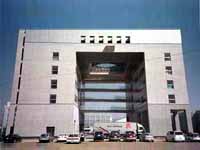| -EHE Inter. Workshop -Public Lecture "Neutrino"(j.) |
| History |
| Chronology |
| Organization |
| Number of staff & Directors |
| Finances (j.) |
| Facilities |
| -Kashiwa Campus -Kamioka -Norikura -Akeno |
| Library(j.) Computer system(j.) Clerk Office(j.) Seminar Room(j.) |
In 1972, the construction of MUTRON (electromagnet spectrometer) began, and general experimental equipments and facilities were getting prepared. In 1973, two international research projects, which had belonged to the Japan Society for the Promotion of Science, were absorbed into the work of the Observatory. One of the two was the deep underground experiment at the Kolar Gold Mine in India, and the other is the high mountain experiment at Mt.Chacaltaya in Bolivia. In 1975, MUTRON was completed, and then the construction of the Akeno Observatory was started. In 1976, Cosmic Ray Observatory was renamed to Institute for Cosmic Ray Research, University of Tokyo. At the same time, three cosmic ray divisions in Institute for Nuclear Study, University of Tokyo, which had engaged in similar researches as those in ICRR were transferred to ICRR. In total, the new ICRR had six divisions plus one attached institution. In 1977, the Akeno Observatory became the second attached institution officially, and in 1979 the 1 square km air shower detector at Akeno and the emulsion chamber at Mt.Fuji were ready. In 1981 the Japan-China collaboration on experiments using emulsion chambers came into existence. In 1983, the experiment of proton decay search started at Kamioka as a collaboration with other universities, and also the facilities for the study of primary cosmic rays were prepared. In the latter half of 1980s' and the succeeding years, big experimental results became yielded, and further expansion and improvement of the experimental facilities came to be made. In 1987, the neutrinos from a supernova were detected at Kamioka for the first time in the world. In the same year, the construction of the 100 square km wide area air shower detector was started. In 1988, the deficit of the solar neutrinos was observed at Kamioka, and in 1989 the very large increase of solar neutrons accompanied with a solar flare was observed at Norikura. In 1900, the the wide area air shower detector was accomplished. In 1901, the construction of Super-Kamiokande was commenced. In 1902, as a product of the collaboration in Australia, very high energy gamma rays from an astronomical source were observed for the first time in the southern hemisphere, and the observation group of gravitational wave was newly added to ICRR. In 1993, the construction of detector for air shower gamma rays was started in Tibet. In 1994, a most energetic air shower, which was not considered to exist theoretically, was observed at Akeno. At Kamioka, an anormalous flux of the atmospheric neutrinos was measured. In 1995, the Kamioka Observatory restarted as the third attached institution. In 1996, the Super-Kamiokande was completed and the full operation began. Then as a result of two-year observation, the discovery that neutrinoes have masses was announced in 1998. From 1999, to investigate more details of neutrino masses, the long base line neutrino experiment started, in which artificial neutrinos ejected from KEK (High Energy Accelerator Research Organization) down to Super-Kamiokande were examined. Moreover, to merge a variety of the observational information and explore a new way of the neutrino study, Research Center for Cosmic Neutrinos was established. Also substantial fund from the Japan Grant-in-aid for Scientific Research was approved to realize a major improvement of the very high energy gamma ray observation in Australia. |
||||||
